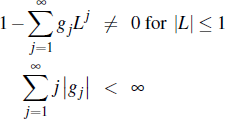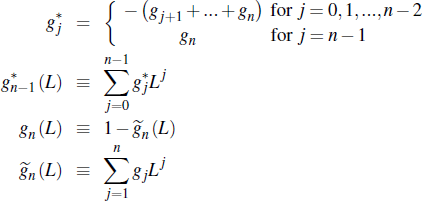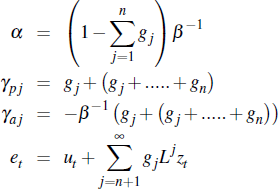RDP 2014-09: Predicting Dwelling Prices with Consideration of the Sales Mechanism Appendix C: Existence of VECM Representation
September 2014 – ISSN 1320-7229 (Print), ISSN 1448-5109 (Online)
- Download the Paper 822KB
From the previous sections, auction and private-treaty prices can be approximated by the unobserved components representation:
where we have assumed that total information weight (ψt + γt = β),
the average weight on buyers own information (ψt
= ψ) and the average dispersion of buyers (θt
= θ) are all constant. If we further assume that  can be linearly approximated
by a stationary ARMA process, zt, the above unobserved
components model can be written as:
can be linearly approximated
by a stationary ARMA process, zt, the above unobserved
components model can be written as:
Using a similar approach to the discussion in Lütkepohl (2006,
pp 546–548), and noting that zt and  are statistically independent of each other, we assume that zt
admits an infinite-order VAR representation:
are statistically independent of each other, we assume that zt
admits an infinite-order VAR representation:
where ut is white noise. We further assume the regularity conditions:
Defining:
it is straightforward to verify that:
Pre-multiplying Equation (C4) by gn (L) and re-arranging terms:
where:
Although we haven't made it explicit, it should be noted that the above coefficients
are, in general, functions of the sample size. Taking an asymptotic approximation
as the sample size increases, (formally  given the previous assumptions, implies (see Lütkepohl (2006)):
given the previous assumptions, implies (see Lütkepohl (2006)):
and so asymptotically the approximation error becomes sufficiently small such that, et ≈ ut .
To recap, we have shown that the unobserved components model in Equations (C1) and (C2) can be approximated by a structural VECM of the form:
Substituting for Δat in the second equation yields Equations (10) and (11)
in the main text (where we let J = n and  .[29].
.[29].
Footnote
Although the previous theory is developed for models of prices in levels, it is straightforward to generalise to log-linear models for prices. In the latter, differences in buyers' and sellers' valuations are measured in percentage terms. The log-linear model is strictly equivalent to our empirical regressions. [29]











